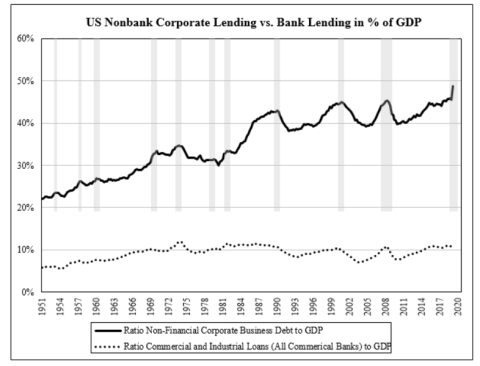Does Borrowing from the Private Markets Cost More Than Borrowing From The Public Markets?
Nonbank corporate lending climbs to a new record high. Amid the COVID-19 crisis, nonbank corporate lending experienced another spike in growth. In the US, nonbank lending now amounts to almost 50% in relation to GDP, the same ratio for bank lending resting at a stagnating average 11% for decades. The primary source of debt for firms is thus progressively provided outside the banking system.
-
prof. dr. Philip Joos

Full Professor
TiSEM: Tilburg School of Economics and Management
View full profile
TiSEM: Department Accountancyphiljoos@tilburguniversity.edu Room K 248 -
prof. dr. Frans de Roon

Full Professor
TiSEM: Tilburg School of Economics and Management
View full profile
TiSEM: Department FinanceF.A.deRoon@tilburguniversity.edu Room T 111

Source: Q1/2020 Nonfinancial Corporate Business, Debt Securities and Loans, retrieved from FRED, Federal Reserve Bank of St. Louis [BCNSDODNS]. Commercial and Industrial Loans from commercial banks, also retrieved from FRED [BUSLOANS]. GDP data from the U.S. Bureau of Economic Analysis. The shaded areas respresenting U.S. recessions according the The National Bureau of Economic Research (NBER).
An important segment of private nonbank lending is the placement of private bonds. Researchers Böni, Joos and de Roon from Tilburg University’s business school TIAS and Tilburg School of Economics and Management (TiSEM) investigated this important nonbank source of finace for firms. They find that yield spreads on private placement bonds are 116 basis points higher than those on public placement bonds. However, controlling for credit risk, liquidity and various market conditions, excess spreads are fully explained by the use of covenants. The latter proxy for a higher level of flexibility and debt renegotiation options as compared to public bonds. Such renegotiation options may be valuable to corporates in the short- and medium term and especially during turbulent times, such as the COVID-19 crisis. The study on the the pricing of primary market private versus public placement bonds is now available at SSRN, the link provided below. The findings of Böni, Joos and de Roon are relevant to the resourceful CFO seeking flexible corporate financing, but also to a larger audience in the areas of investment, finance and entrepreneurship. Firms and investors are well advised to compare and critically evaluate innovation made available by various instruments in the expanding private debt market, where private bond placements represent only one of various options to finance new business, says Böni.
Böni, Pascal and de Roon, Frans A. and Joos, Philip, Does Borrowing from the Private Bond Market Cost More than Borrowing from the Public Bond Market? (August 23, 2020).






